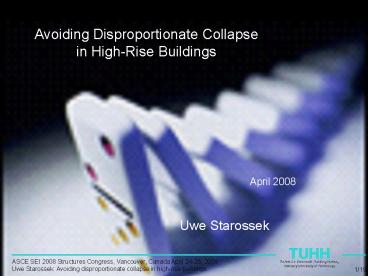Avoiding disproportionate collapse - PowerPoint PPT Presentation
1 / 19
Title:
Avoiding disproportionate collapse
Description:
World Trade Center September 11, 2001 'Studies should be conducted to determine ... 11 /19. Hamburg University of Technology ... – PowerPoint PPT presentation
Number of Views:169
Avg rating:3.0/5.0
Title: Avoiding disproportionate collapse
1
Avoiding Disproportionate Collapse in High-Rise
Buildings
April 2008
Uwe Starossek
ASCE SEI 2008 Structures Congress, Vancouver,
Canada April 24-26, 2008 Uwe Starossek Avoiding
disproportionate collapse in high-rise buildings
Hamburg University of Technology
1/19
2
World Trade CenterSeptember 11, 2001
Studies should be conducted to determine
whether there are feasible design and
construction features that would permit such
buildings to arrest or limit a collapse, once it
began. (FEMA Report 403, May 2002)
3
Suggested design approach
? on the one hand, the design methods as
described in the current codes are
applied ? on the other hand, an additional
assessment with regard to collapse resistance
is made ? not necessarily based on
reliability theory but rather on
judgment and a decision-making process ?
analyses are generally carried out
deterministically
4
Design criteria (additional assessment regarding
p.c.)
?
?
?
?
5
Design objectives
- assumable extent of accidental circumstances
- assumable extent of initial local failure
- acceptable extent of collapse progression
- acceptable extent of damage to remaining
structure - applicable load combinations and safety factors
6
Additional design criteria
?
?
7
Design strategies
- high safety against local failure (prevent local
failure) - specific local resistance of key elements
- non-structural protective measures
- design for load case local failure (presume
local failure) - alternate paths
- isolation by segmentation
- prescriptive design rules (indirect design)
8
Confederation Bridge, Canada
- alternate paths cannot be provided
- isolation by segmentation
9
Confederation Bridge, Canada
insertion of hinges
10
Confederation Bridge, Canada
- segment borders must be able to sustain either
large forces - or large displacements
- reduction of continuity can lead to increase of
robustness
insertion of hinges
11
More examples
- isolation by segmentation
Pentagon Building
Paris Airport Terminal
weak
strong
weak
weak
12
More examples
- isolation by segmentation
structural system
Murrah Federal Building
Collapse stopped at rebar discontinuity in
transfer girder!
13
Comparison of design methods
segmentation
alternate paths
14
Collapse-resistant design of high-rise building
(1)
Specific local resistance of primary system
leading to an arrangement of independent
primary and secondary load
transfer systems
15
Collapse-resistant design of high-rise building
(1)
secondary load transfer system
alternatively, limiting collapse of secondary
system through horizontal segmentation
primary system with high specific local resistance
transfer of loads of failing floors to floors
below thus providing alternate paths
16
Collapse-resistant design of high-rise building
(2)
Vertical segmentation with
energy-dissipating shock-absorbing zones
17
Collapse-resistant design of high-rise building
(2)
segment border
shock-absorbing segment border
shock-absorbing device telescoping steel
tubes with compressible filling
vertical segmentation by shock-absorbing zones
18
Conclusions
- The adequacy of a particular design method
depends on the - structural system and the design objectives.
- For large and slender high-rise buildings, the
alternate-path - approach can be used if a set of limited
accidental actions is - agreed upon.
- Larger accidental circumstances are tolerable
when the design of - the primary system is based on the
specific-local-resistance - approach.
- In that case, an arrangement of independent
primary and - secondary load transfer systems is arrived at.
- Alternatively, a collapse can be arrested by
vertical segmentation - with energy being dissipated in shock-absorbing
zones.
19
Thank you!
ASCE SEI 2008 Structures Congress, Vancouver,
Canada April 24-26, 2008 Uwe Starossek Avoiding
disproportionate collapse in high-rise buildings
Hamburg University of Technology
19/19































